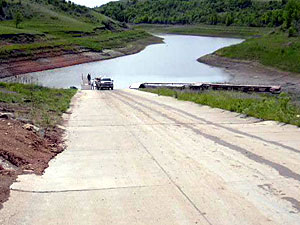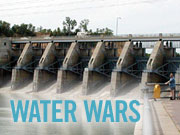Photos
Your Voice
| |||||||||||||||||||||||||||||||||
Water Wars: Recreation on the Missouri River
July 2, 2003
 |
| A long boat ramp from Indian Hills Resort to the Lake Sakakawea. (MPR Photo/Dan Gunderson) |
Riverdale, ND — In the past five years Lake Sakakawea's water level has fallen 30 feet. Grass is growing where fish once swam. Mike Quinn stands atop a hill looking out over a bay where he used to occasionally dock his sailboat.
"If you look over here on this bank you can see where the high water level is actually about 30 feet above where you see the water line right now," says Quinn.
Mike Quinn runs a sailing charter business, taking passengers from the plains of central North Dakota to the rugged badlands of the west. His 34 foot sailboat needs about six feet of water to enter a bay.
 | |||
"There are areas that you can't access now that are some of the prettiest areas I've ever seen," says Quinn. "Right now it's just a giant mud flat where in the past there would have been 20 feet of water."
Lake Sakakawea was near the record high water mark in 1997 but it's been dropping ever since. It may fall another ten feet by the end of this summer. That would end Mike Quinn's sailing season early.
"That's a real economic hassle to me because I'll lose two months of business if I have to take the boat out because they drop the lake levels," says Quinn.
Lake Sakakawea is a manmade reservoir. It's designed to hold heavy spring runoff. The water is released throughout the year to generate electricity and control the level of the Missouri river downstream so barge traffic can continue. But for the last several years there's been a drought in the west. There's not enough water to refill the reservoir.
Brad Wolfe lives in Hazen, ND, and often fishes on Lake Sakakawea. He says it can be a challenge just getting a boat in the water. Some boat ramps are high and dry. The federal government has spent millions of dollars extending dozens of ramps.
 | |||
Some people say low water makes fishing better. Brad Wolfe says he's having a harder time finding fish. He points to what used to be a favorite walleye spot. It's now dry ground
"A lot of our cover you can see on these bluffs is exposed out of the water. You can see the natural water line is 15 to 20 feet higher than the level of the water," says Wolfe. "Used to be excellent fishing on the north shore here. Now it's like the dead sea."
But Sakakawea is a big lake. Fishing is reported to be great in other areas. Many local businesses depend on anglers like Brad Wolfe to keep the cash register ringing.
"This morning I bought five dollars worth of bait and $25 worth of gas. If I wouldn't be fishing that's a $25 gas sale I wouldn't need," says Wolfe.
Anglers spend about $23 million a year at businesses around Lake Sakakawea, according to the North Dakota Game and Fish Department.
 | |||
But reports of low water are scaring some people away. And that's starting to take a toll on resorts around the lake. Tolly Holtan and her family run Indian Hills resort. She says this summer is off to the slowest start in the 20 years she's been at the resort.
At Indian Hills resort, docks are marooned on mud. Grass is growing up around the kids fishing pier. The resort can't refuel boats because the pump hose doesn't reach the water. The concrete boat ramp has been lengthened three times. It now reaches the very bottom of the bay. There's just enough water to allow small boats to get onto the lake.
"At one time we had 15 large houseboats in the back here. Now there's none," says Tolly Holtan. "There's one on the parking lot and three in our yard that haven't been in the water for three years."
This isn't the first time Tolly Holtan has seen the bottom of the bay. In the late 1980s the lake was so low the resort had to dredge a channel to the lake.
What really worries Tolly Holtan is the possibility of a major fish kill. Rainbow smelt are the primary food source for game fish in the lake. Smelt are a coldwater fish. With the lake low, the water could get too warm in July and August. Warm water doesn't have enough oxygen to keep the smelt alive. Tolly Holtan remembers a fish kill during the last period of low water.
 | |||
"It looked like popcorn on the water out here, the smelt were coming down from the Van Hook arm where it's shallow. That end of the lake the smelt died," says Holtan. "They came around that corner up there and it was just hard to watch. And the gulls. I don't know where they came from, there were thousands. Just for a few days. They cleaned em up. The gulls couldn't even fly they were so full."
Tolly Holtan says publicity about low water and a potential fish kill is clearly scaring away anglers. But she says those who come are finding great fishing so far this summer.
Fish kill is of great concern for those who manage Lake Sakakawea. North Dakota Game and Fish staff can't discuss the issue because North Dakota is suing the U.S. Army Corp of Engineers. The state says low water levels in Lake Sakakawea violate state water quality standards.
Experts says if the water level doesn't increase this summer, there will almost certainly be a fish kill. They just don't know how severe the die off will be.
Along the Missouri river just below the Garrison dam is one of the largest fish hatcheries in the U.S. Run by the federal government, raises millions of walleyes and hundreds of thousand of other species to stock the reservoir and other lakes.
Fish like walleye, northern pike and bass are cool water fish. But salmon, trout and rainbow smelt are coldwater fish. U.S. Fish and Wildlife Coldwater Fisheries Biologist John Gravning says they do best in water colder than 60 degrees.
 | |||
"They'll survive in 60 some degree water and even into the low 70s, but you're almost at the fatal point when you hit 70 degrees because it's just too warm and not enough oxygen," says Gravning. There are indications the rainbow smelt in Lake Sakakawea are showing signs of a potential population crash.
"The last two years they haven't seen much of a spawn so we may be in the beginning of it right now. So with these two low years we could be headed for trouble," says Gravning.
If the smelt die, salmon and trout will likely be wiped out. Walleye will survive, but without a primary food source the population would likely shrink substantially.
People around the lake blame the Corp of Engineers. They say the federal agency releases water to keep barges afloat downstream while their livelihood dries up.
Bill Mitzel says this is a crisis that could have been avoided. Mitzel publishes Dakota Country, a regional hunting and fishing magazine.
"Drought comes on gradually. It just doesn't occur instantly. Therefore I don't think it requires a lot of foresight to see what's happening out there and give you some time to manage accordingly. And that's what the corp's failed to do," says Mitzel.
U.S. Army Corp of Engineers spokesman Paul Johnston says the agency is trying to balance all of the demands for water along the Missouri river, but there simply is not enough water.
"It really hurts those people, I understand that," says Johnston. "I've been to many of those places and it's a real heartache to see that happening. The problem is we're just not getting the water in that we need to replenish those reservoirs."
But North Dakotans with a financial stake in the water level of Lake Sakakawea are not convinced. They believe they're being shortchanged, not by mother nature, but by politics and beauracracy.
|
News Headlines
|
Related Subjects
|

